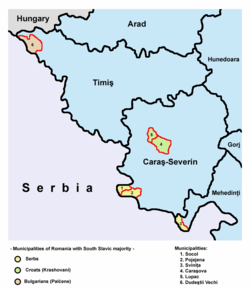| Revision as of 09:02, 27 December 2006 editEvlekis (talk | contribs)30,289 edits Don't mess about, they are a seperate community and are linked to all South Slavs← Previous edit | Revision as of 10:25, 27 December 2006 edit undo89.172.206.18 (talk) rv, they are CroatsNext edit → | ||
| Line 6: | Line 6: | ||
| |langs=] (traditionally); ] (declared in census) | |langs=] (traditionally); ] (declared in census) | ||
| |rels=Predominantly ] | |rels=Predominantly ] | ||
| |related=other ], especially ] | |related=other ], especially ] | ||
| }} | }} | ||
| Line 58: | Line 58: | ||
| ] | ] | ||
| ] | ] | ||
| ⚫ | ] | ||
| ] | ] | ||
| ] | ] | ||
| ] | ] | ||
| ⚫ | ] | ||
| ] | ] | ||
Revision as of 10:25, 27 December 2006
Ethnic group| Regions with significant populations | |
|---|---|
| Romania (Caraş-Severin County) | |
| Languages | |
| Torlakian (traditionally); Croatian language (declared in census) | |
| Religion | |
| Predominantly Roman Catholic | |
| Related ethnic groups | |
| other Slavic peoples, especially Croats |
The Krashovani (Croatian and Serbian: Krašovani, Крашовани, Karašovani or Krašovanje, Karaševci and Koroševci; Romanian: Caraşoveni, Cârşoveni, Cotcoreţi or Cocoşi; also known as Krashovans) are a South Slavic people indigenous to Caraşova and other nearby locations in Caraş-Severin County within the Romanian Banat.
It is estimated that there are around 5,000 Krashovani in Romania, with only some 200 opting for the nationality itself, the remainder choosing Croatian ethnicity.
Geography
Krashovani form a majority in two communes of Caraş-Severin County: Caraşova and Lupac.
According to the 2002 census in Romania, the population of Caraşova commune comprises 84.60% Croats, 4.96% others (presumably Krashovan), 4.47% Roma, 4.41% Romanians, etc. The population of Lupac commune comprises 93.38% Croats, 5.32% Romanians, etc. The 79.75% of population of Caraşova municipality and 93.45% of population of Lupac municipality declared to speak Croatian as mother tongue in 2002 census.
Origin and history

Original Slavic settlements had existed in these regions before the Krashovan migration. Krashovani themselves are mostly descendants of the Torlakian inhabitants of eastern Serbia, namely the region around the Timok River.
Some of the Krashovani originate from Turopolje region of present-day Croatia (they are being referred as Turopoljci). Because of the long-time influence of other Krashovani, who speak the Torlakian dialect, the original (Kajkavian) dialect of this group also became Torlakian. Other groups are supposedly Croats from the Franciscan province of Bosna Srebrena.
The Krashovani were also considered Bulgarians by some (mainly Bulgarian) scientists from the first half of the 20th century (such as G. Cibrus, M. Mladenov, K. Telbizov, and T. Balkanski). However, these claims are based on the fact that these and some other Bulgarian scientists consider the entire Torlakian-speaking Slavic population ethnically Bulgarian, just as Serbian scientists consider it ethnically Serbian. The question of whether the Torlakian dialect belongs to the eastern or western branches of South Slavic languages is also disputed, and it is often classified as a transitional dialect between the two.
Krashovani migration to Banat can be traced to the 1370s, when fleeing the Ottoman onslaught, they moved there from Timok region (in that time ruled by Bulgaria). The Catholic supremacy inside the Kingdom of Hungary (to which the Banat region belonged at the time) may account for their distinctiveness from the rest of the Torlakian-speaking population in present-day eastern Serbia.
According to the Austrian population census there were over 10,000 Krashovans in the Romanian Banat. In 1896 the Austro-Hungarian census listed around 7,500 Krashovans; the same was stated by the authorities of the Kingdom of Romania in 1940. Their number dropped to 6,500 in 1992 according to the census of the government of Romania.
Ever since the Romanian Revolution, the government of Romania has awarded special minority status and privileges to its ethnic Serb citizens. The Democratic Union of Serbs and Krashovani of Romania (Uniunea Democratică a Sârbilor si Caraşovenilor din România) was founded in 1989.
Language and religion

Their dialect is an archaic speech elsewhere preserved only in the area of eastern and southern Serbia and in the Republic of Macedonia and Bulgaria, the Torlakian dialect of the Timok valley around Zaječar.
However, their religion has more recently set them apart from Eastern Orthodox Serbs in the Banat, despite the common language and a long history of solidarity (partly continued to this day through joint Serb-Krashovan organizations).
See also
- Minorities of Romania
- Caraşova
- Lupac
- Torlaks
- Torlakian dialect
- Croats of Romania
- Serbs of Romania
- Banat Bulgarians
External links
| Ethnic groups in Romania | |
|---|---|
| Dominant group | Romanians (16,792,868) |
| Officially recognised minorities |
|
| Non-recognized minorities |
|
| Historical ethnic groups |
|
| Immigrant groups |
|
| |